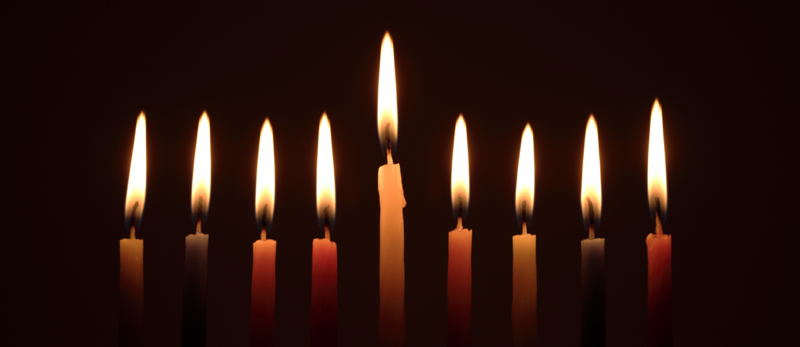Hanukkah, one of the most commonly celebrated Jewish holidays, is a joyful eight-day celebration that occurs during the darkest and coldest season of the year for many people. The holiday, also known as the Festival of Lights, brings light, laughter, and comfort into our homes and communities as we celebrate with candles, wine, families, and friends.
Light comes both physically, with the illumination of an extra candle each day, and metaphorically, with a newer focus on charitable gifts and tikkun olam during the holiday. Hanukkah (also spelled Chanukah) celebrates the triumph of a small party of Jewish rebels (led by Judah Maccabee and his brothers, collectively known as the Maccabees) over the armies of Syria in 165 B.C.E. and the subsequent liberation and "rededication" of the Temple in Jerusalem. Modern celebrations of Hanukkah focus on family and friends and include the lighting of the Hanukkah (also called a ); singing and playing special songs and games (); and eating foods prepared in oil including , , bimuelos (fried dough puffs) and keftes de prasas (leek patties).
CELEBRATE AT HOME
Lighting the Hanukkah Candles
From one Hanukkah to the next, it can be a challenge to remember in which direction to add candles and in which direction to light them. Here’s what you need to know: When the menorah is facing you, the candle for the first night is placed in the right-most holder of the eight-branched menorah and the is placed in its holder, which is raised or otherwise distinguished from the rest of the candleholders.
Anyone may chant or recite the blessings by lighting and holding the shamash, reciting the blessings, and then using the shamash to light the candles (from left to right, so that the kindling begins with the newest light).
Two blessings are chanted or recited every night of Hanukkah. The first is a blessing over the candles themselves. The second blessing expresses thanks for the miracle of deliverance. A third blessing – the Shehecheyanu prayer, marking all joyous occasions in Jewish life – is chanted or recited only on the first night.
On each successive night, an additional candle is placed to the immediate left of the previous night’s candle, and the candles are lit from left to right, so the kindling begins with the newest light. Since these lights are holy, we aren’t supposed to make practical use of them (e.g., using them to see or read by, or lighting other candles with them); therefore, we use the shamash to light the ones that mark each night of the holiday.
Candles are added to the hanukkiyah (menorah) from right to left but are kindled from left to right. The newest candle is lit first. (On the Shabbat of Hanukkah, kindle the Hanukkah lights first and then the Shabbat candles.)


Light the shamash (the helper candle) first, using it to kindle the rest of the Hanukkah lights. As you do, say or sing:
Hebrew Text
בָּרוּךְ אַתָּה, יְיָ אֱלֹהֵֽינוּ, מֶֽלֶךְ הָעוֹלָם,
אֲשֶׁר קִדְּשָֽׁנוּ בְּמִצְוֺתָיו וְצִוָּֽנוּ לְהַדְלִיק נֵר שֶׁל חֲנֻכָּה.
Transliteration
Baruch atah, Adonai Eloheinu, Melech haolam, asher kid’shanu b’mitzvotav v’tsivanu l’hadlik ner shel Hanukkah.
Translation
Blessed are You, Adonai our God, Sovereign of all, who hallows us with mitzvot, commanding us to kindle the Hanukkah lights.
Hebrew Text
בָּרוּךְ אַתָּה, יְיָ אֱלֹהֵֽינוּ, מֶֽלֶךְ הָעוֹלָם,
שֶׁעָשָׂה נִסִּים לַאֲבוֹתֵֽינוּ וְאִמּוֹתֵֽינוּ בַּיָּמִים הָהֵם בַּזְּמַן הַזֶּה.
Transliteration
Baruch atah, Adonai Eloheinu, Melech haolam, she-asah nisim laavoteinu v’imoteinu bayamim hahaeim baz’man hazeh.
Translation
Blessed are You, Adonai our God, Sovereign of all, who performed wonderous deeds for our ancestors in days of old at this season.
Download a printable version of the Hanukkah blessings here.
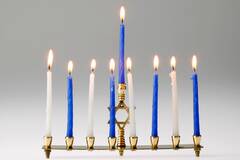
Menorah is a Hebrew word meaning “candelabrum” and sometimes refers to the nine-branched ceremonial lamp in which the Hanukkah candles are placed and blessed each night of the holiday. The nine branches include eight branches, one for each day of the holiday, and one branch for the candle that is used to light the other candles. In ancient times, oil was used in the menorah. Over time, candles were substituted for oil. The Hanukkah menorah can also be called a hanukkiyah.
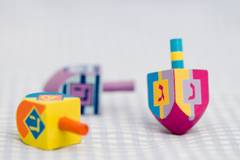
The word dreidel derives from a German word meaning “spinning top,” and is the toy used in a Hanukkah game adapted from an old German gambling game. (Historically, Hanukkah was one of the few times of the year when rabbis permitted games of chance.) The four sides of the top bear four Hebrew letters: nun, gimel, hey, and shin. Players begin by putting into a central pot or “kitty” a certain number of coins, foil-wrapped chocolate disks known as , nuts, buttons or other small objects.
Each player in turn spins the dreidel and proceeds as follows:
- נ nun – take nothing
- ג gimel – take everything
- ה hei – take half
- ש shin – put one in
Over time, the letters on the dreidel were reinterpreted to stand for the first letter of each word in the Hebrew statement, “Neis gadol hayah sham,” which means “A great miracle happened there” and refers to the defeat of the Syrian army and the re-dedication of the Temple. In Israel, one letter on the dreidel differs from those used in the rest of the world. The shin has been replaced with a pey, transforming the Hebrew statement into “Neis gadol hayah po,” which means “A great miracle happened here.”
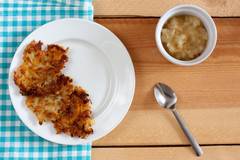
A latke is a potato pancake fried in oil, and is a traditional food eaten to celebrate the miracle of the oil in the story of Hanukkah. Foods cooked in oil serve as a symbol of the legend of the jar of oil that lasted for eight days.
Try this recipe for
Classic Latkes (Potato Pancakes)
by TINA WASSERMAN
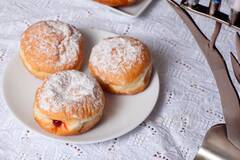
Sufganiyot, or jelly donuts, are another traditional fried food enjoyed for Hanukkah.
Try this recipe for
Israeli Sufganiyot
by ORLY ZIV


